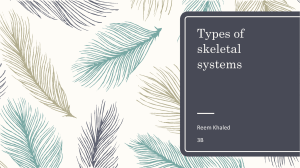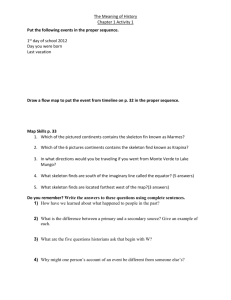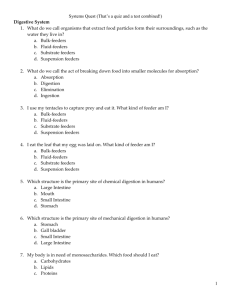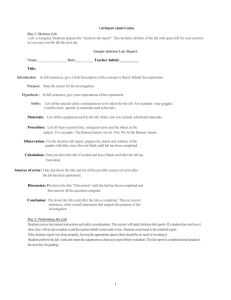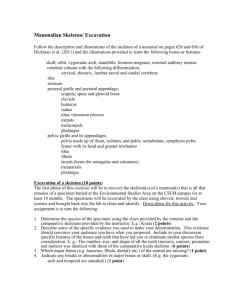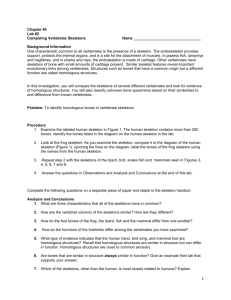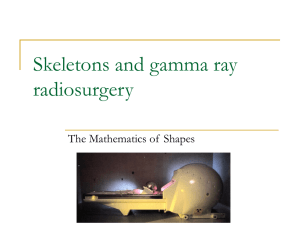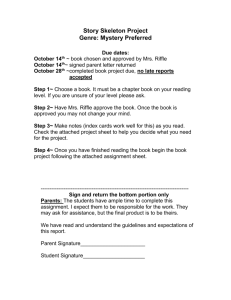the Note
advertisement
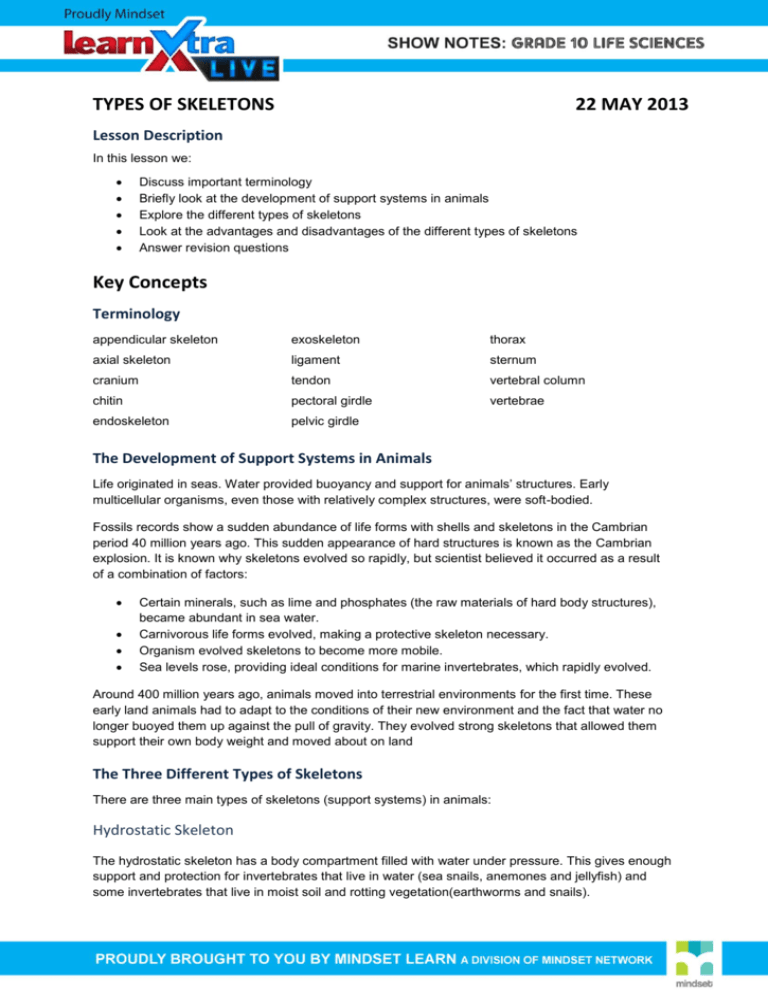
TYPES OF SKELETONS 22 MAY 2013 Lesson Description In this lesson we: Discuss important terminology Briefly look at the development of support systems in animals Explore the different types of skeletons Look at the advantages and disadvantages of the different types of skeletons Answer revision questions Key Concepts Terminology appendicular skeleton exoskeleton thorax axial skeleton ligament sternum cranium tendon vertebral column chitin pectoral girdle vertebrae endoskeleton pelvic girdle The Development of Support Systems in Animals Life originated in seas. Water provided buoyancy and support for animals’ structures. Early multicellular organisms, even those with relatively complex structures, were soft-bodied. Fossils records show a sudden abundance of life forms with shells and skeletons in the Cambrian period 40 million years ago. This sudden appearance of hard structures is known as the Cambrian explosion. It is known why skeletons evolved so rapidly, but scientist believed it occurred as a result of a combination of factors: Certain minerals, such as lime and phosphates (the raw materials of hard body structures), became abundant in sea water. Carnivorous life forms evolved, making a protective skeleton necessary. Organism evolved skeletons to become more mobile. Sea levels rose, providing ideal conditions for marine invertebrates, which rapidly evolved. Around 400 million years ago, animals moved into terrestrial environments for the first time. These early land animals had to adapt to the conditions of their new environment and the fact that water no longer buoyed them up against the pull of gravity. They evolved strong skeletons that allowed them support their own body weight and moved about on land The Three Different Types of Skeletons There are three main types of skeletons (support systems) in animals: Hydrostatic Skeleton The hydrostatic skeleton has a body compartment filled with water under pressure. This gives enough support and protection for invertebrates that live in water (sea snails, anemones and jellyfish) and some invertebrates that live in moist soil and rotting vegetation(earthworms and snails). (Images of an earthworm and a worm showing the presences of a hydrostatic skeleton.) Exoskeleton The exoskeleton support system is a chitinous or calcareous hard covering on the outside (‘exo’outside) of a body, which supports and protects internal tissue. All invertebrate arthropods (such as insects, crustaceans and arachnids) have exoskeletons. (Images of a crab, woodlice, horse shoe crab and garden snail showing the presences of a exoskeleton.) Endoskeleton The endoskeleton support system is made of soft or hard bones, joints, muscles, tendons and ligaments and is found inside (‘endo’-inside) a body. A soft endoskeleton is made of cartilage (as in sharks). A had endoskeleton is made up of bone (as in vertebrates). Endo skeletons protect the soft body tissue and allow for free movement, greater growth and strength. (Images of a leopard and a frog showing the presences of an endoskeleton.) The Advantages and Disadvantages of Different Types of Skeletons Advantages Hydrostatic Skeleton Aquatic animals can increase in size because support of water reduces effects of gravity. Land animals easily burrow into soil for protection. Movement needs little energy because it is helped by water or moist land environment. Allows for passive diffusion of important substances, such as oxygen and water, into the organism. Exoskeleton Endoskeleton Plates of armour to support and protect soft tissue and organs. Greater flexibility Muscles and organs are inside for protection. Can grow with increase in size. Provides shape and structural support. Limited energy needed for more growth because skeleton is added to, not replaced Prevents dehydration. Gives shape and structural support. Provides good leverage for muscle attachment. Bones can vary in size to support mass. Disadvantages Hydrostatic Skeleton No solid support for muscle, limbs or appendages. Land animals cannot increase in size because of the limited support of their muscles. If land animals got bigger, they would collapse under their own weight. No escape from predators. Cannot quickly escape or make defence movements. No protective tissue Must have a moist or water habitat to survive and prevent dehydration. Exoskeleton Limits the size of animal. Endoskeleton No overall protection to the body (but vital organs are well protected). Creates difficulties in growth Muscles located on the outside, so can be easily damaged. Animals needs to moult to increase in size Does not prevent dehydration. Uses a lot of energy In the re growth stage after each moulting. Poor leverage for muscle action. Bones are fairly heavy and movement is energy-intensive. Interesting Facts Animals can have both an endoskeleton and an exoskeleton, or an endoskeleton and a hydrostatic skeleton: The skeleton of a tortoise is made of two parts; the external shell or exoskeleton and an endoskeleton made up of bones. Certain echinoderms, such as star fish, have an endoskeleton made up tiny calcium spines or granules and use hydrostatic pressure for locomotion. Questions Question 1 Complete the table below by filling in the comparisons of the different types of skeletons. (2x9) (18) Types of skeletons Two Advantages Two Disadvantages Two examples of animals with this skeleton. Hydrostatic skeleton Exoskeleton Endoskeleton Question 2 Study the bony endoskeleton of the vertebrates shown in the diagram below. Relate the structure of the skeleton to the animal’s mode of locomotion. (Frog, pigeon and a mole) Question 3 Name four functions of the skeleton. With each function explain how the skeleton achieves the function. (12) Links Magnification simulation http://www.cellsalive.com/howbig.htm Animal / Plant Cell http://www.cellsalive.com/cells/cell_model.htm 3D animation of a cell: http://www.xvivo.net/the-inner-life-of-the-cell/ Reference List 1. Via Afrika Life Sciences; Grade 10 Learner’s Book; M. Bowie, A. Johannes, R. Mhlongo, E. Pretorius. 2. Shuters Top Class Life Sciences Grade 10 Learners Book; P. Ayerst, R. Langely, P. Majozi, A. Metherell, D. Smith. 3. Spot On, Life Sciences Learners’ Book, C Dawson, P Holm, G Jackson; H Skinner 4. Oxford Successful Life Sciences Learner’s Book, W. Bezuidenhout, A Clark, S Copley, C Drew, R Engelbrecht; J Goliath
